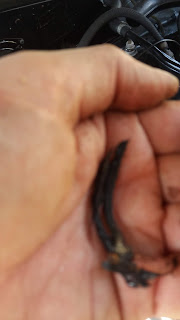I had found that my heater valve was leaking whenever it was set to "cold", presumably because in this position it opposed the flow of coolant and the pressure resulted in leakage. When set to "hot" the valve is open and presents no restriction to flow, so no leaks! I ordered a new valve and gasket from MGB Hive.
First up, I loosened the block filler cap-nut and the bottom radiator hose. I drained about half of the coolant through the hose, collecting it in a bowl for reuse. You need to get the heater empty and the block level below that of the valve to avoid leaks when you detach the heater hose and remove the valve.
 |
| Valve as fitted- note poor condition of sealant around its junction with the block. Also coolant has washed oily covering off the block below the valve suggesting past leakage. |
Removing the valve is simple enough- detach the cable from the end fix and solderless nipple, then its just two bolts, one each at top and bottom of the mounting flange. However it helps to disconnect the plug leads and remove the dipstick to gain a little more room. Access is relatively easy for the top bolt (5/16 socket on a wobble bar) but the lower one is hard to get at- I used an 5/16 stubby spanner.
 |
| Valve removed- gasket below is in poor condition and appears to have been reused by coating in sealant. |
 |
| nasty silicone sealant surrounding the gasket |
The sealant had also been squeezed where it shouldn't go and I removed a plug of it from inside the block- hopefully this will improve coolant flow.
The sealant had also been compressed into the bottom of both bolt holes which needed cleaning out, furthermore it hadn't worked! It was clear that coolant had also seeped into the bolt holes and both bolts were corroded. I cleaned the holes out with WD40 to remove lingering water and then cleaned the bolts up.
 |
| Heater bolts. Left cleaned and right as found. |
I treated them to corrosion block grease when I refitted. However if the gasket is working the coolant shouldn't reach these bolts.
I cleaned up the block mating flange.
...and installed the new valve with its new gasket. The valve tends to adopt a natural position. This is actually the "cold" position but its not quite at the end of the valve's travel. Opening the valve from this point gives progressive opening until at fully open the flow is unrestricted. However, its important to set the cable at the cold position that the valve adopts, because if you try to close it further against its natural springiness - i.e. to make it "more cold"- it opens again! The old valve didn't behave like this but the new one was fully open at both extremes of its movement. Whats worse- I don't think its is actually fully off even in this preset "cold" position. I'm not terribly impressed with this and I think reflects departures from OEM in some replacements available these days. Anyway I set the panel control to "cold" and attached the cable to give full cold on the panel equal to the valves natural "off"



No comments:
Post a Comment